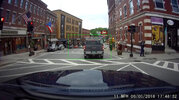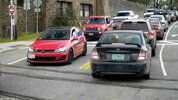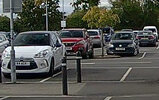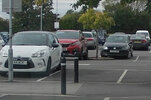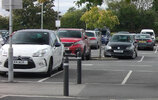That shows x4, so I assume an 8mm coupled with a small sensor...
DAP's videos show that he has x4.17, so pretty much the same magnification...
And yet you write:
My 4K dashcam can also see through glass, nothing special about that, they all have to look through our own windscreens! Although with this example it would be at the limit of resolution, so maybe wouldn't actually read the plate, wouldn't quite read the "Vermont" at the top of the plate on the previous image either.
Realistically, you are achieving 2x more resolution than a 4K dashcam with a normal FoV would, the same as an 8K dashcam would produce across 4x the field of view.
For plate reading, probably better off investing in a Starvis-2 4K dashcam, once they are available, unless your roads are a lot smoother and straighter and better illuminated than my roads.
True, other cameras can see through windshields, but not quite as consistently or as well as my telephoto. It's not really an important aspect of why one would want a telephoto though. It was just an interesting anecdotal thing I tacked on the end of my post. It seems typical of you to repeatedly dwell on something like this as a way of sidestepping everything else I've said. As always Nigel, you elide practically everything I say in my posts because you haven't really much of anything worthwhile to offer other than what you've done here today in what amounts to a daylong, gratuitous, petty
argument caviling against the concept of telephoto lens dash cams.
I often wonder why you so often initiate spats like this and demand that anyone and everyone adhere to your personal preferences about how to use dash cams or what kind of camera or lens is best. (If it's not a Viofo you often act with disdain apparently because you are one of their loyal forum operatives.)
I recall recently when you insisted that EVERYONE should use 2560x1080 resolution because that is YOUR preference, stating that "
you do not need the sky, because you are not recording meteors, and do not need the front of your car and part of your dash in the image, because they never change and there is nothing interesting there anyway", BUT that's been
demonstrated not to be true at all and many here do not agree with you, preferring instead 2560 x 1440 resolution to capture things like overhead traffic lights or side impacts to your fenders. You engaged in a very similar argument not long ago as well about whether to include your car's hood when you aim the camera, which you seem to think is completely unnecessary but many others find important to include. The fact is Nigel, that people should do what they find works best for them based on their own personal experience and preferences rather than what some
overweening guy who spends most of his waking hours on a web forum proclaims is best for them.
And now, here you are insisting in post after post that a 4K camera is superior and preferable to a separate telephoto regardless of the fact that you've never pesonally experienced using one. And speaking of ignoring what I say in my posts you completely disregard the concerns I've raised about the impracticality of 4K cameras in regard to heat, memory requirements, the prospect of handing off video to parties who don't have 4K monitors or graphics cards, etc. etc.
Personally, I have ZERO interest in owning a 4K camera as my preference is 2K cameras which I consider the perfect "sweet spot" for dash cam resolution. And I much prefer the telephoto cams I've built as a secondary angle of view camera rather than having a single unit to rely upon. I find telephoto cams to be practical, extremely useful, fun and interesting. I capture all kinds of interesting and unexpected things typical dash cams miss and that I wouldn't go hunting for by zoom in or cropping indivdual 4K frames. Telephoto cams have opened up a world that previously never existed in dash cams and that is the reason so many have expressed an interest in them. Indeed, I think you'd be quite surprised by just how many DCT members have adopted them. Some remain quiet once they are up and running, or maybe they check in with a question now and again but I hear from them all the time. None of them would likely trade in their telephoto for a single camera. Then again, they've experienced them first hand rather than making opinionated assumptions.
If you don't like the concept and don't wish to use a telephoto lens, then fine, but who the hell are you to dictate what others should or shouldn't do?
And why do you keep using the term FOV? The appropriate term here is AOV.
And just what they hell is this "
unless your roads are a lot smoother and straighter and better illuminated than my roads" business all about? This comes across as more of your habitual UK vs USA nation bashing? Explain yourself please!


